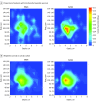Optimal Combination of Compression Rate and Depth During Cardiopulmonary Resuscitation for Functionally Favorable Survival
- PMID: 31411632
- PMCID: PMC6694399
- DOI: 10.1001/jamacardio.2019.2717
Optimal Combination of Compression Rate and Depth During Cardiopulmonary Resuscitation for Functionally Favorable Survival
Abstract
Importance: Previous studies of basic cardiopulmonary resuscitation (CPR) indicate that both chest compression rate (CCR) and chest compression depth (CCD) each are associated with survival probability after out-of-hospital cardiac arrest. However, an optimal CCR-CCD combination has yet to be identified, particularly with respect to age, sex, presenting cardiac rhythm, and CPR adjunct use.
Objectives: To identify an ideal CCR-CCD combination associated with the highest probability of functionally favorable survival and to assess whether this combination varies with respect to age, sex, presenting cardiac rhythm, or CPR adjunct use.
Design, setting, and participants: This cohort study used data collected between June 2007 and November 2009 from a National Institutes of Health (NIH) clinical trials network registry of out-of-hospital and in-hospital emergency care provided by 9-1-1 system agencies participating in the network across the United States and Canada (n = 150). The study sample included 3643 patients who had out-of-hospital cardiac arrest and for whom CCR and CCD had been simultaneously recorded during an NIH clinical trial of a CPR adjunct. Subgroup analyses included evaluations according to age, sex, presenting cardiac rhythm, and application of a CPR adjunct. Data analysis was performed from September to November 2018.
Interventions: Standard out-of-hospital cardiac arrest interventions compliant with the concurrent American Heart Association guidelines as well as use of the CPR adjunct device in half of the patients.
Main outcomes and measures: The optimal combination of CCR-CCD associated with functionally favorable survival (modified Rankin scale ≤3) overall and by age, sex, presenting cardiac rhythm, and CPR adjunct use.
Results: Of 3643 patients, 2346 (64.4%) were men; the mean (SD) age was 67.5 (15.7) years. The identified optimal CCR-CCD for all patients was 107 compressions per minute and a depth of 4.7 cm. When CPR was performed within 20% of this value, survival probability was significantly higher (6.0% vs 4.3% outside that range; odds ratio, 1.44; 95% CI, 1.07-1.94; P = .02). The optimal CCR-CCD combination remained similar regardless of age, sex, presenting cardiac rhythm, or CPR adjunct use. The identified optimal CCR-CCD was associated with significantly higher probabilities of survival when the CPR device was used compared with standard CPR (odds ratio, 1.90; 95% CI, 1.06-3.38; P = .03), and the device's effectiveness was dependent on being near the target CCR-CCD combination.
Conclusions and relevance: The findings suggest that the combination of 107 compressions per minute and a depth of 4.7 cm is associated with significantly improved outcomes for out-of-hospital cardiac arrest. The results merit further investigation and prospective validation.
Conflict of interest statement
Figures

Comment in
-
Push Hard, Push Fast, Do Not Stop-Optimal Chest Compression Rate and Depth.JAMA Cardiol. 2019 Sep 1;4(9):908-909. doi: 10.1001/jamacardio.2019.2838. JAMA Cardiol. 2019. PMID: 31411633 No abstract available.
References
-
- Benjamin EJ, Blaha MJ, Chiuve SE, et al. ; American Heart Association Statistics Committee and Stroke Statistics Subcommittee . Heart disease and stroke statistics-2017 update: a report from the American Heart Association. Circulation. 2017;135(10):e146-e603. doi:10.1161/CIR.0000000000000485 - DOI - PMC - PubMed
Publication types
MeSH terms
LinkOut - more resources
Full Text Sources
Medical

